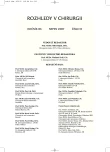Approximative Intestinal Anastomosis in newborns with Multifocal Necrotizing Enterocolitis
Authors:
M. Rygl; R. Škába; K. Pýcha; J. Kučera *; Z. Straňák *
Authors‘ workplace:
Klinika dětské chirurgie UK Praha, 2. LF a FN Motol, Katedra dětské chirurgie IPVZ, Praha
přednosta: prof. MUDr. J. Šnajdauf, DrSc.
; Ústav pro péči o matku a dítě, Podolí, Katedra gynekologie a porodnictví IPVZ, Praha
přednosta: doc. MUDr. J. Feyereisl, CSc.
*
Published in:
Rozhl. Chir., 2007, roč. 86, č. 8, s. 415-419.
Category:
Monothematic special - Original
Overview
Multifocal necrotizing enterocolitis (NEC) may result in extensive bowel necrosis and short bowel syndrome. Authors present case report of premature newborn (BW 1700 g, gestational age 30 w.) where an extensive multisegmental NEC of small and large intestine was found during first explorative laparotomy. Proximal jejunostomy 28 cm beyond ligament of Treitz was performed and the rest of involved intestine was left in situ. After 48 hours multiple small bowel resections were performed leaving 12 cm of small intestine (5 short segments) distal to the jejunostomy. Five approximative anastomoses were performed to restore continuity among these segments and ileocaecal valve. Each of approximative anastomosis was constructed with limited number of 4–6 interrupted stitches and all anastomoses healed without complication. Intestinal continuity between proximal jejunostomy and the reconstructed segment of ileum was re-established nine weeks later. Total length of small bowel was 50 cm. The patient was discharged at the age of 5 months weighing 4145 g with supplemental pareneteral nutrition. The technique of rapid approximative anastomosis may contribute to save maximal intestinal length in cases with the risk of short bowel syndrome.
Key words:
necrotizing enterocolitis – short bowel syndrome – approximative anastomosis
Sources
1. Wilmore, D. W. Factors correlating with a successful outcome following extensive intestinal resection in newborn infants. J. Pediatr., 1972; 80 : 88–95.
2. Banieghbal, B., Davies, M. R. Damage control laparotomy for generalized necrotizing enterocolitis. World J. Surg., 2004; 28 : 183–186.
3. Rowe, M. I., Reblock, K. K., Kurkchubasche, A. G., Healey, P. J. Necrotizing enterocolitis in the extremely low birth weight infant. J. Pediatr. Surg., 1994; 29 : 987–990; discussion 990–981.
4. Voss, M., Moore, S. W., van der Merwe, I., Pieper, C. Fulminanting necrotising enterocolitis: outcome and prognostic factors. Pediatr. Surg. Int., 1998; 13 : 576–580.
5. Blakely, M. L., Tyson, J. E., Lally, K. P., McDonald, S., Stoll, B. J., Stevenson, D. K., Poole, W. K., Jobe, A. H., Wright, L. L., Higgins, R. D. Laparotomy versus peritoneal drainage for necrotizing enterocolitis or isolated intestinal perforation in extremely low birth weight infants: outcomes through 18 months adjusted age. Pediatrics, 2006; 117: e680–687.
6. Fasoli, L., Turi, R. A., Spitz, L., Kiely, E. M., Drake, D., Pierro, A. Necrotizing enterocolitis: extent of disease and surgical treatment. J. Pediatr. Surg., 1999; 34 : 1096–1099.
7. Hall, N. J., Curry, J., Drake, D. P., Spitz, L., Kiely, E. M., Pierro, A. Resection and primary anastomosis is a valid surgical option for infants with necrotizing enterocolitis who weigh less than 1000 g. Arch. Surg., 2005; 140 : 1149–1151.
8. Hofman, F. N., Bax, N. M., van der Zee, D. C., Kramer, W. L. Surgery for necrotising enterocolitis: primary anastomosis or enterostomy? Pediatr. Surg. Int., 2004; 20 : 481–483.
9. Singh, M., Owen, A., Gull, S., Morabito, A., Bianchi, A. Surgery for intestinal perforation in preterm neonates: anastomosis vs stoma. J. Pediatr. Surg., 2006; 41 : 725–729; discussion 725–729.
10. Butter, A., Flageole, H., Laberge, J. M. The changing face of surgical indications for necrotizing enterocolitis. J. Pediatr. Surg., 2002; 37 : 496–499.
11. Goyal, A., Manalang, L. R., Donnell, S. C., Lloyd, D. A. Primary peritoneal drainage in necrotising enterocolitis: an 18-year experience. Pediatr. Surg. Int., 2006; 22 : 449–452.
12. Sugarman, I. D., Kiely, E. M. Is there a role for high jejunostomy in the management of severe necrotising enterocolitis? Pediatr. Surg. Int., 2001; 17 : 122–124.
13. Moore, T. C. Successful use of the „patch, drain, and wait“ laparotomy approach to perforated necrotizing enterocolitis: is hypoxia-triggered „good angiogenesis“ involved? Pediatr. Surg. Int., 2000; 16 : 356–363.
14. Vaughan, W. G., Grosfeld, J. L., West, K., Scherer, L. R. 3rd, Villamizar, E., Rescorla, F. J. Avoidance of stomas and delayed anastomosis for bowel necrosis: the ‘clip and drop-back’ technique. J. Pediatr. Surg., 1996; 31 : 542–545.
15. Ein, S. H., Marshall, D. G., Girvan, D. Peritoneal drainage under local anesthesia for perforations from necrotizing enterocolitis. J. Pediatr. Surg., 1977; 12 : 963–967.
16. Ahmed, T., Ein, S., Moore, A. The role of peritoneal drains in treatment of perforated necrotizing enterocolitis: recommendations from recent experience. J. Pediatr. Surg., 1998; 33 : 1468–1470.
17. Cass, D. L., Brandt, M. L., Patel, D. L., Nuchtern, J. G., Minifee, P. K., Wesson, D. E. Peritoneal drainage as definitive treatment for neonates with isolated intestinal perforation. J. Pediatr. Surg., 2000; 35 : 1531–1536.
18. Lessin, M. S., Schwartz, D. L., Wesselhoeft, C. W. Jr. Multiple spontaneous small bowel anastomosis in premature infants with multisegmental necrotizing enterocolitis. J. Pediatr. Surg., 2000; 35 : 170–172.
Labels
Surgery Orthopaedics Trauma surgeryArticle was published in
Perspectives in Surgery

2007 Issue 8
Most read in this issue
- Complications of Laparoscopic Procedures of Inguinal Hernias , Diagnosed on Colonoscopy
- Ten –Year Experience with Barron Ligature in the Ostrava Surgical Clinic
- Videothoracoscopy, Standard and Uncommon Indications
- Vacuum-assisted Closure as a Treatment Modality for Surgical Site Infection in Cardiac Surgery
